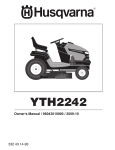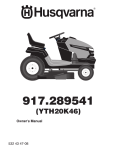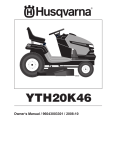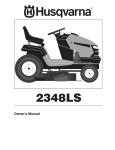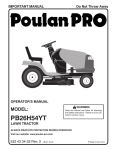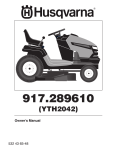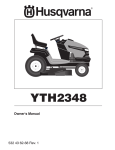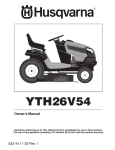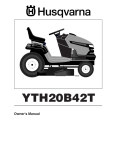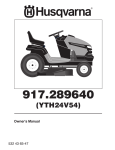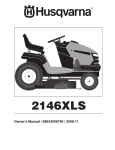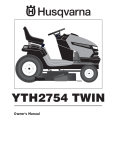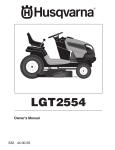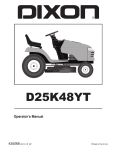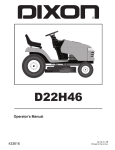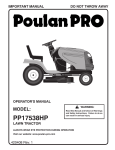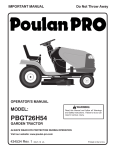Download Husqvarna 532 43 95-58 User's Manual
Transcript
07002 YTH21K46 Owner's Manual 532 43 95-58 SAFETY RULES Safe Operation Practices for Ride-On Mowers DANGER: THIS CUTTING MACHINE IS CAPABLE OF AMPUTATING HANDS AND FEET AND THROWING OBJECTS. FAILURE TO OBSERVE THE FOLLOWING SAFETY INSTRUCTIONS COULD RESULT IN SERIOUS INJURY OR DEATH. • • WARNING: In order to prevent accidental starting when setting up, transporting, adjusting or making repairs, always disconnect spark plug wire and place wire where it cannot contact spark plug. • WARNING: Do not coast down a hill in neutral, you may lose control of the tractor. • • WARNING: Tow only the attachments that are recommended by and comply with specifications of the manufacturer of your tractor. Use common sense when towing. Operate only at the lowest possible speed when on a slope. Too heavy of a load, while on a slope, is dangerous. Tires can lose traction with the ground and cause you to lose control of your tractor. • • • • WARNING • Engine exhaust, some of its constituents, and certain vehicle components contain or emit chemicals known to the State of California to cause cancer and birth defects or other reproductive harm. • WARNING II. SLOPE OPERATION Battery posts, terminals and related accessories contain lead and lead compounds, chemicals known to the State of California to cause cancer and birth defects or other reproductive harm. Wash hands after handling. Slopes are a major factor related to loss of control and tip-over accidents, which can result in severe injury or death. Operation on all slopes requires extra caution. If you cannot back up the slope or if you feel uneasy on it, do not mow it. • Mow up and down slopes, not across. • Watch for holes, ruts, bumps, rocks, or other hidden objects. Uneven terrain could overturn the machine. Tall grass can hide obstacles. • Choose a low ground speed so that you will not have to stop or shift while on the slope. • Do not mow on wet grass. Tires may lose traction. Always keep the machine in gear when going down slopes. Do not shift to neutral and coast downhill. • Avoid starting, stopping, or turning on a slope. If the tires lose traction, disengage the blades and proceed slowly straight down the slope. • Keep all movement on the slopes slow and gradual. Do not make sudden changes in speed or direction, which could cause the machine to roll over. • Use extra care while operating machine with grass catchers or other attachments; they can affect the stability of the machine. Do no use on steep slopes. • Do not try to stabilize the machine by putting your foot on the ground. • Do not mow near drop-offs, ditches, or embankments. The machine could suddenly roll over if a wheel is over the edge or if the edge caves in. I. GENERAL OPERATION • • • • • • • • • Slow down before turning. Never leave a running machine unattended. Always turn off blades, set parking brake, stop engine, and remove keys before dismounting. Disengage blades when not mowing. Shut off engine and wait for all parts to come to a complete stop before cleaning the machine, removing the grass catcher, or unclogging the discharge chute. Operate machine only in daylight or good artificial light. Do not operate the machine while under the influence of alcohol or drugs. Watch for traffic when operating near or crossing roadways. Use extra care when loading or unloading the machine into a trailer or truck. Always wear eye protection when operating machine. Data indicates that operators, age 60 years and above, are involved in a large percentage of riding mowerrelated injuries. These operators should evaluate their ability to operate the riding mower safely enough to protect themselves and others from serious injury. Follow the manufacturer's recommendation for wheel weights or counterweights. Keep machine free of grass , leaves or other debris build-up which can touch hot exhaust / engine parts and burn. Do not allow the mower deck to plow leaves or other debris which can cause build-up to occur. Clean any oil or fuel spillage before operating or storing the machine. Allow machine to cool before storage. Read, understand, and follow all instructions on the machine and in the manual before starting. Do not put hands or feet near rotating parts or under the machine. Keep clear of the discharge opening at all times. Only allow responsible adults, who are familiar with the instructions, to operate the machine. Clear the area of objects such as rocks, toys, wire, etc., which could be picked up and thrown by the blades. Be sure the area is clear of bystanders before operating. Stop machine if anyone enters the area. Never carry passengers. Do not mow in reverse unless absolutely necessary. Always look down and behind before and while backing. Never direct discharged material toward anyone. Avoid discharging material against a wall or obstruction. Material may ricochet back toward the operator. Stop the blades when crossing gravel surfaces. Do not operate machine without the entire grass catcher, discharge chute, or other safety devices in place and working. 2 SAFETY RULES Safe Operation Practices for Ride-On Mowers III. CHILDREN Tragic accidents can occur if the operator is not alert to the presence of children. Children are often attracted to the machine and the mowing activity. Never assume that children will remain where you last saw them. • Keep children out of the mowing area and in the watchful care of a responsible adult other than the operator. • Be alert and turn machine off if a child enters the area. • Before and while backing, look behind and down for small children. • Never carry children, even with the blades shut off. They may fall off and be seriously injured or interfere with safe machine operation. Children who have been given rides in the past may suddenly appear in the mowing area for another ride and be run over or backed over by the machine. • Never allow children to operate the machine. • Use extra care when approaching blind corners, shrubs, trees, or other objects that may block your view of a child. GENERAL SERVICE • Never operate machine in a closed area. • Keep all nuts and bolts tight to be sure the equipment is in safe working condition. • Never tamper with safety devices. Check their proper operation regularly. • Keep machine free of grass, leaves, or other debris build-up. Clean oil or fuel spillage and remove any fuelsoaked debris. Allow machine to cool before storing. • If you strike a foreign object, stop and inspect the machine. Repair, if necessary, before restarting. • Never make any adjustments or repairs with the engine running. • Check grass catcher components and the discharge chute frequently and replace with manufacturer's recommended parts, when necessary. • Mower blades are sharp. Wrap the blade or wear gloves, and use extra caution when servicing them. • Check brake operation frequently. Adjust and service as required. • Maintain or replace safety and instruction labels, as necessary. IV. TOWING • • • • • Tow only with a machine that has a hitch designed for towing. Do not attach towed equipment except at the hitch point. Follow the manufacturer's recommendation for weight limits for towed equipment and towing on slopes. Never allow children or others in or on towed equipment. On slopes, the weight of the towed equipment may cause loss of traction and loss of control. Travel slowly and allow extra distance to stop. • • • V. SERVICE SAFE HANDLING OF GASOLINE To avoid personal injury or property damage, use extreme care in handling gasoline. Gasoline is extremely flammable and the vapors are explosive. • Extinguish all cigarettes, cigars, pipes, and other sources of ignition. • Use only approved gasoline container. • Never remove gas cap or add fuel with the engine running. Allow engine to cool before refueling. • Never fuel the machine indoors. • Never store the machine or fuel container where there is an open flame, spark, or pilot light such as on a water heater or other appliances. • Never fill containers inside a vehicle or on a truck or trailer bed with plastic liner. Always place containers on the ground away from your vehicle when filling. • Remove gas-powered equipment from the truck or trailer and refuel it on the ground. If this is not possible, then refuel such equipment with a portable container, rather than from a gasoline dispenser nozzle. • Keep the nozzle in contact with the rim of the fuel tank or container opening at all times until fueling is complete. Do not use a nozzle lock-open device. • If fuel is spilled on clothing, change clothing immediately. • Never overfill fuel tank. Replace gas cap and tighten securely. • • • • • • • • • 3 Be sure the area is clear of bystanders before operating. Stop machine if anyone enters the area. Never carry passengers. Do not mow in reverse unless absolutely necessary. Always look down and behind before and while backing. Never carry children, even with the blades shut off. They may fall off and be seriously injured or interfere with safe machine operation. Children who have been given rides in the past may suddenly appear in the mowing area for another ride and be run over or backed over by the machine. Keep children out of the mowing area and in the watchful care of a responsible adult other than the operator. Be alert and turn machine off if a child enters the area. Before and while backing, look behind and down for small children. Mow up and down slopes (15° Max), not across. Choose a low ground speed so that you will not have to stop or shift while on the slope. Avoid starting, stopping, or turning on a slope. If the tires lose traction, disengage the blades and proceed slowly straight down the slope. If machine stops while going uphill, disengage blades, shift into reverse and back down slowly. Do not turn on slopes unless necessary, and then, turn slowly and gradually downhill, if possible. PRODUCT SPECIFICATIONS Gasoline Capacity and type: Oil Type (API-SG-SL): Oil Capacity: Spark Plug: Ground Speed (MPH): Charging System: Battery: Blade Bolt Torque: CONGRATULATIONS on your purchase of a new tractor. It has been designed, engineered and manufactured to give you the best possible dependability and performance. Should you experience any problem you cannot easily remedy, please contact your nearest authorized servicecenter/ department We have competent, well-trained technicians and the proper tools to service or repair this tractor. Please read and retain this manual. The instructions will enable you to assemble and maintain your tractor properly. Always observe the “SAFETY RULES”. 2.5 Gallons Unleaded Regular SAE 10W30 (above 32°F) SAE 5W30 (below 32°F) W/ Filter: 51 oz W/O Filter: 35 oz Champion RC12YC (Gap: .030") Forward: 0 - 5.2 Reverse: 0 - 2.9 15 AMPS @ 3600 RPM AMP/HR: 28 MIN. CCA: 230 Case Size: U1R 45-55 FT. LBS. CUSTOMER RESPONSIBILITIES • • • Read and observe the safety rules. Follow a regular schedule in maintaining, caring for and using your tractor. Follow the instructions under “Maintenance” and “Storage” sections of this owner’s manual. WARNING: This tractor is equipped with an internal combustion engine and should not be used on or near any unimproved forest-covered, brush-covered or grass-covered land unless the engine’s exhaust system is equipped with a spark arrester meeting applicable local or state laws (if any). If a spark arrester is used, it should be maintained in effective working order by the operator. In the state of California the above is required by law (Section 4442 of the California Public Resources Code). Other states may have similar laws. Federal laws apply on federal lands. A spark arrester for the muffler is available through your nearest authorized service center/department. TABLE OF CONTENTS SAFETY RULES ......................................................... 2-3 PRODUCT SPECIFICATIONS ....................................... 4 CUSTOMER RESPONSIBILITIES................................. 4 ASSEMBLY ................................................................. 5-6 OPERATION ............................................................. 7-13 4 MAINTENANCE SCHEDULE ...................................... 14 MAINTENANCE ..................................................... 14-17 SERVICE AND ADJUSTMENTS ............................ 18-23 STORAGE .................................................................... 24 TROUBLESHOOTING ............................................ 25-26 REPAIR PARTS ...................................................... 27-42 UNASSEMBLED PARTS Slope Sheet Key (1) Oil Drain Tube (2) Keys ASSEMBLY Your new tractor has been assembled at the factory with the exception of those parts left unassembled for shipping purposes. TOOLS REQUIRED FOR ASSEMBLY A socket wrench set will make assembly easier. Standard wrench sizes are listed. (1) 1/2" wrench Tire pressure gauge (2) 7/16" wrenches Utility knife Pliers LABEL When right or left hand is mentioned in this manual, it means when you are in the operating position (seated behind the steering wheel). TO REMOVE TRACTOR FROM CARTON UNPACK CARTON • • • FIG. 1 Remove all accessible loose parts and parts cartons from carton . Cut along dotted lines on all four panels of carton. Remove end panels and lay side panels flat. Check for any additional loose parts or cartons and remove. ADJUST SEAT (See Fig. 2) • • • BEFORE REMOVING TRACTOR FROM SKID Sit in seat. Lift up adjustment lever (A) and slide seat until a comfortable position is reached which allows you to press clutch/brake pedal all the way down. Release lever to lock seat in position. A TO CHECK BATTERY (See Fig. 1) • Lift seat to raised position. NOTE: If this battery is put into service after month and year indicated on label (label is located between terminals) charge battery for minimum of one hour at 6-10 amps. (See "BATTERY" in Maintenance section of this manual for charging instructions). • For battery and battery cable installation see "REPLACING BATTERY" in the "Service and Adjustments" section in this manual. FIG. 2 5 ASSEMBLY ✓CHECKLIST NOTE: You may now roll your tractor off the skid. Follow the instructions below to remove the tractor from the skid. WARNING: Before starting, read, understand and follow all instructions in the Operation section of this manual. Be sure tractor is in a well-ventilated area. Be sure the area in front of tractor is clear of other people and objects. BEFORE YOU OPERATE YOUR NEW TRACTOR, WE WISH TO ASSURE THAT YOU RECEIVE THE BEST PERFORMANCE AND SATISFACTION FROM THIS QUALITY PRODUCT. PLEASE REVIEW THE FOLLOWING CHECKLIST: ✓ ✓ ✓ ✓ ✓ TO ROLL TRACTOR OFF SKID (See Operation section for location and function of controls) • Raise attachment lift lever to its highest position. • Release parking brake by depressing brake pedal. • Place freewheel control in disengaged position to disengage transmission (See “TO TRANSPORT” in the Operation section of this manual). • Roll tractor forward off skid. Continue with the instructions that follow. CHECK TIRE PRESSURE The tires on your tractor were overinflated at the factory for shipping purposes. Correct tire pressure is important for best cutting performance. • Reduce tire pressure to PSI shown on tires. All assembly instructions have been completed. No remaining loose parts in carton. Battery is properly prepared and charged. Seat is adjusted comfortably and tightened securely. All tires are properly inflated. (For shipping purposes, the tires were overinflated at the factory). ✓ Be sure mower deck is properly leveled side-to-side/ front-to-rear for best cutting results. (Tires must be properly inflated for leveling). ✓ Check mower and drive belts. Be sure they are routed properly around pulleys and inside all belt keepers. ✓ Check wiring. See that all connections are still secure and wires are properly clamped. ✓ Before driving tractor, be sure freewheel control is in “transmission engaged” position (See “TO TRANSPORT” in the Operation section of this manual). WHILE LEARNING HOW TO USE YOUR TRACTOR, PAY EXTRA ATTENTION TO THE FOLLOWING IMPORTANT ITEMS: CHECK DECK LEVELNESS For best cutting results, mower housing should be properly leveled. See “TO LEVEL MOWER HOUSING” in the Service and Adjustments section of this manual. CHECK FOR PROPER POSITION OF ALL BELTS ✓ ✓ See the figures that are shown for replacing motion and mower blade drive belts in the Service and Adjustments section of this manual. Verify that the belts are routed correctly. CHECK BRAKE SYSTEM After you learn how to operate your tractor, check to see that the brake is operating properly. See “TO CHECK BRAKE” in the Service and Adjustments section of this manual. Fuel tank is filled with fresh, clean, regular unleaded gasoline. ✓ Become familiar with all controls, their location and function. Operate them before you start the engine. ✓ ✓ Be sure brake system is in safe operating condition. ✓ 6 Engine oil is at proper level. Be sure Operator Presence System and Reverse Operation System (ROS) are working properly (See the Operation and Maintenance sections in this manual). It is important to purge the transmission before operating your tractor for the first time. Follow proper starting and transmission purging instructions (See “TO START ENGINE” and “PURGE TRANSMISSION” in the Operation section of this manual). OPERATION These symbols may appear on your tractor or in literature supplied with the product. Learn and understand their meaning. REVERSE ENGINE OFF LIGHTS ON NEUTRAL REVERSE OPERATION SYSTEM (ROS) FUEL HIGH LOW ENGINE ON BATTERY CHOKE ENGINE START REVERSE FAST IGNITION SWITCH PARKING BRAKE FORWARD SLOW MOWER HEIGHT MOWER LIFT CLUTCH/BRAKE PEDAL CRUISE CONTROL 15 ATTACHMENT CLUTCH DISENGAGED ATTACHMENT CLUTCH ENGAGED DANGER, KEEP HANDS AND FEET AWAY 15 SLOPE HAZARDS KEEP AREA CLEAR (SEE SAFETY RULES SECTION) DANGER indicates a hazard which, if not avoided, will result in death or serious injury. FREE WHEEL (Automatic Models only) WARNING indicates a hazard which, if not avoided, could result in death or serious injury. CAUTION indicates a hazard which, if not avoided, might result in minor or moderate injury. CAUTION when used without the alert symbol, indicates a situation that could result in damage to the tractor and/or engine. Failure to follow instructions could result in serious injury or death. The safety alert symbol is used to identify safety information about hazards which can result in death, serious injury and/or property damage. HOT SURFACES indicates a hazard which, if not avoided, could result in death, serious injury and/or property damage. FIRE indicates a hazard which, if not avoided, could result in death, serious injury and/or property damage. 7 OPERATION KNOW YOUR TRACTOR READ THIS OWNER'S MANUAL AND SAFETY RULES BEFORE OPERATING YOUR TRACTOR Compare the illustrations with your tractor to familiarize yourself with the locations of various controls and adjustments. Save this manual for future reference. P H D G E B F C K A J M L FIG. 3 Our tractors conform to the applicable safety standards of the American National Standards Institute. (A) ATTACHMENT LIFT LEVER - Used to raise and lower the mower or other attachments mounted to your tractor. (B) BRAKE PEDAL - Used for braking the tractor and starting the engine. (C) PARKING BRAKE - Locks clutch/brake pedal into the brake position. (D) THROTTLE/CHOKE CONTROL - Used for starting and controlling engine speed. (E) ATTACHMENT CLUTCH LEVER - Used to engage the mower blades, or other attachments mounted to your tractor. (F) IGNITION SWITCH - Used for starting and stopping the engine. (G) REVERSE OPERATION SYSTEM (ROS) "ON" POSITION - Allows operation of mower or other powered attachment while in reverse. (H) LIGHT SWITCH - Turns the headlights on and off. (J) CRUISE CONTROL LEVER - Used to set forward movement of tractor at desired speed without holding the forward drive pedal. (K) FORWARD DRIVE PEDAL - Used for forward movement of tractor. (L) REVERSE DRIVE PEDAL - Used for reverse movement of tractor. (M) FREEWHEEL CONTROL - Disengages transmission for pushing or slowly towing the tractor with the engine off. (P) SERVICE REMINDER / HOUR METER - Indicates when service is required for the engine and mower. 8 OPERATION The operation of any tractor can result in foreign objects thrown into the eyes, which can result in severe eye damage. Always wear safety glasses or eye shields while operating your tractor or performing any adjustments or repairs. We recommend standard safety glasses or a wide vision safety mask worn over spectacles. HOW TO USE YOUR TRACTOR GROUND DRIVE • To stop ground drive, depress brake pedal into full “BRAKE” position. TO SET PARKING BRAKE (See Fig. 4) I M P O R TA N T : F O R W A R D A N D R E V E R S E D R I V E PEDALS RETURN TO NEUTRAL POSITION WHEN NOT DEPRESSED. Your tractor is equipped with an operator presence sensing switch. When engine is running, any attempt by the operator to leave the seat without first setting the parking brake will shut off the engine. • Depress brake pedal (B) all the way down and hold. • Pull parking brake lever (C) up and hold, release pressure from brake pedal (B), then release parking brake lever. Pedal should remain in brake position. Make sure parking brake will hold tractor secure. ENGINE • Move throttle control between half and full speed (fast) position. NOTE: Failure to move throttle control between half and full speed (fast) position, before stopping may cause engine to “backfire”. • Turn ignition key (F) to “STOP” position and remove key. Always remove key when leaving tractor to prevent unauthorized use. C B IMPORTANT: LEAVING THE IGNITION SWITCH IN ANY POSITION OTHER THAN "STOP" WILL CAUSE THE BATTERY TO BE DISCHARGED, (DEAD). NOTE: Under certain conditions when tractor is standing idle with the engine running, hot engine exhaust gases may cause “browning” of grass. To eliminate this possibility, always stop engine when stopping tractor on grass areas. FIG. 4 STOPPING (See Fig. 5) CAUTION: Always stop tractor completely, as described above, before leaving the operator's position; to empty grass catcher, etc. MOWER BLADES • To stop mower blades,move attachment clutch lever to “DISENGAGED” position. TO USE THROTTLE CONTROL (D) (See Fig. 6) Always operate engine at full speed (fast). • Operating engine at less than full speed (fast) reduces engines operating efficiency. • Full speed (fast) offers the best bagging and mower performance. D ( ) ATTACHMENT CLUTCH SWITCH “DISENGAGED” ( ) ATTACHMENT CLUTCH SWITCH “ENGAGED” F FIG. 5 FIG. 6 9 OPERATION • TO MOVE FORWARD AND BACKWARD (See Fig. 7) The direction and speed of movement is controlled by the forward and reverse drive pedals. • Start tractor and release parking brake. • Slowly depress forward (K) or reverse (L) drive pedal to begin movement. Ground speed increases the further down the pedal is depressed. • TO ADJUST GAUGE WHEELS (See Fig. 9) Gauge wheels are properly adjusted when they are slightly off the ground when mower is at the desired cutting height in operating position. Gauge wheels then keep the deck in proper position to help prevent scalping in most terrain conditions. NOTE: Adjust gauge wheels with tractor on a flat level surface. • Adjust mower to desired cutting height (See “TO ADJUST MOWER CUTTING HEIGHT” in this section of manual). • With mower in desired height of cut position, gauge wheels should be assembled so they are slightly off the ground. Install gauge wheel in appropriate hole. Tighten securely. • Repeat for all, installing gauge wheel in same adjustment hole. TO USE CRUISE CONTROL (J) (See Fig. 7) The cruise control feature can be used for forward travel only. J The average lawn should be cut to approximately 2-1/2" during the cool season and to over 3" during hot months. For healthier and better looking lawns, mow often and after moderate growth. For best cutting performance, grass over 6" in height should be mowed twice. Make the first cut relatively high; the second to desired height. K L FIG. 7 SYSTEM CHARACTERISTICS The cruise control should only be used while mowing or transporting on relatively smooth, straight surfaces. Other conditions such as trimming at slow speeds may cause the cruise control to disengage. Do not use the cruise control on slopes, rough terrian or while trimmimg or turning. • With forward drive pedal depressed to desired speed, pull cruise control lever (J) up and hold while lifting your foot off the pedal, then release the lever. To disengage the cruise control, depress the brake pedal or tap on forward drive pedal. FIG. 9 TO OPERATE MOWER (See Fig. 10) Your tractor is equipped with an operator presence sensing switch. Any attempt by the operator to leave the seat with the engine running and the attachment clutch engaged will shut off the engine. You must remain fully and centrally positioned in the seat to prevent the engine from hesitating or cutting off when operating your equipment on rough, rolling terrain or hills. 1. Select desired height of cut with attachment lift lever. 2. Start mower blades by engaging attachment clutch. TO ADJUST MOWER CUTTING HEIGHT (See Fig. 8) The position of the attachment lift lever (A) determines the cutting height. A TO STOP MOWER BLADES Disengage attachment clutch control. S FIG. 8 • Put attachment lift lever in desired cutting height slot. The cutting height range is approximately 1" to 4". The heights are measured from the ground to the blade tip with the engine not running. These heights are approximate and may vary depending upon soil conditions, height of grass and types of grass being mowed. FIG. 10 10 OPERATION TO TRANSPORT (See Figs. 3 and 12) CAUTION: Do not operate the mower without either the entire grass catcher, on mowers so equipped, or the deflector shield (S) in place. When pushing or towing your tractor, be sure to disengage transmission by placing freewheel control in freewheeling position. Free wheel control is located at the rear drawbar of tractor. • Raise attachment lift to highest position with attachment lift control. • Pull freewheel control out and down into the slot and release so it is held in the disengaged position. • Do not push or tow tractor at more than two (2) MPH. • To reengage transmission, reverse above procedure. NOTE: To protect hood from damage when transporting your tractor on a truck or a trailer, be sure hood is closed and secured to tractor. Use an appropriate means of tying hood to tractor (rope, cord, etc.). REVERSE OPERATION SYSTEM (ROS) (See Fig. 11) Your tractor is equipped with a Reverse Operation System (ROS). Any attempt by the operator to travel in the reverse direction with the attachment clutch engaged will shut off the engine unless ignition key is placed in the ROS "ON" position. WARNING: Backing up with the attachment clutch engaged while mowing is strongly discouraged. Turning the ROS "ON", to allow reverse operation with the attachment clutch engaged, should only be done when the operator decides it is necessary to reposition the machine with the attachment engaged. Do not mow in reverse unless absolutely necessary. TRANSMISSION ENGAGED USING THE REVERSE OPERATION SYSTEM Only use if you are certain no children or other bystanders will enter the mowing area. • Depress brake pedal all the way down. • With engine running, turn ignition key counterclockwise to ROS "ON" position. TRANSMISSION DISENGAGED FIG. 12 TOWING CARTS AND OTHER ATTACHMENTS 02828 ROS "ON" POSITION Tow only the attachments that are recommended by and comply with specifications of the manufacturer of your tractor. Use common sense when towing. Too heavy of a load, while on a slope, is dangerous. Tires can lose traction with the ground and cause you to lose control of your tractor. ENGINE "ON" POSITION (NORMAL OPERATING) FIG. 11 • • • Look down and behind before and while backing. Slowly depress reverse drive pedal to start movement. When use of the ROS is no longer needed, turn the ignition key clockwise to engine "ON" position. SERVICE REMINDER/HOUR METER Service reminder shows the total number of hours the engine has run and flashes to indicate that the engine or mower needs servicing. When service is required, the service reminder will flash for two hours. To service engine and mower, see the Maintenance section of this manual. NOTE: Service reminder runs when the ignition key is in any position but "STOP". For accurate reading, be sure key remains in the "STOP" position when engine is not running. TO OPERATE ON HILLS CAUTION: Do not drive up or down hills with slopes greater than 15° and do not drive across any slope. • • • • • • Choose the slowest speed before starting up or down hills. Avoid stopping or changing speed on hills. If stopping is absolutely necessary, push brake pedal quickly to brake position and engage parking brake. To restart movement, slowly release parking brake and brake pedal. Slowly depress appropriate drive pedal to slowest setting. Make all turns slowly. 11 OPERATION BEFORE STARTING THE ENGINE TO START ENGINE (See Fig. 3) When starting the engine for the first time or if the engine has run out of fuel, it will take extra cranking time to move fuel from the tank to the engine. • Be sure freewheel control is in the transmission engaged position. • Sit on seat in operating position, depress brake pedal and set parking brake. • Move attachment clutch to “DISENGAGED” position. • Move throttle control to choke position. NOTE: Before starting, read the warm and cold starting procedures below. • Insert key into ignition and turn key clockwise to “START” position and release key as soon as engine starts. Do not run starter continuously for more than fifteen seconds per minute. If the engine does not start after several attempts, move throttle control to fast position, wait a few minutes and try again. If engine still does not start, move the throttle control back to the choke position and retry. CHECK ENGINE OIL LEVEL The engine in your tractor has been shipped, from the factory, already filled with summer weight oil. • Check engine oil with tractor on level ground. • Remove oil fill cap/dipstick and wipe clean, reinsert the dipstick and screw cap tight, wait for a few seconds, remove and read oil level. If necessary, add oil until “FULL” mark on dipstick is reached. Do not overfill. • For cold weather operation you should change oil for easier starting (See “OIL VISCOSITY CHART” in the Maintenance section of this manual). • To change engine oil, see the Maintenance section in this manual. ADD GASOLINE • Fill fuel tank to bottom of filler neck. Do not overfill. Use fresh, clean, regular unleaded gasoline with a minimum of 87 octane. (Use of leaded gasoline will increase carbon and lead oxide deposits and reduce valve life). Do not mix oil with gasoline. Purchase fuel in quantities that can be used within 30 days to assure fuel freshness. WARM WEATHER STARTING (50° F/10° C and above) • When engine starts, move the throttle control to the fast position. • The attachments and ground drive can now be used. If the engine does not accept the load, restart the engine and allow it to warm up for one minute using the choke as described above. CAUTION: Wipe off any spilled oil or fuel. Do not store, spill or use gasoline near an open flame. COLD WEATHER STARTING (50° F/10° C and below) • When engine starts, allow engine to run with the throttle control in the choke position until the engine runs roughly, then move throttle control to fast position. This may require an engine warm-up period from several seconds to several minutes, depending on the temperature. IMPORTANT: WHEN OPERATING IN TEMPERATURES BELOW 32°F(0°C), USE FRESH, CLEAN WINTER GRADE GASOLINE TO HELP INSURE GOOD COLD WEATHER STARTING. CAUTION: Alcohol blended fuels (called gasohol or using ethanol or methanol) can attract moisture which leads to separation and formation of acids during storage. Acidic gas can damage the fuel system of an engine while in storage. To avoid engine problems, the fuel system should be emptied before storage of 30 days or longer. Drain the gas tank, start the engine and let it run until the fuel lines and carburetor are empty. Use fresh fuel next season. See Storage Instructions for additional information. Never use engine or carburetor cleaner products in the fuel tank or permanent damage may occur. AUTOMATIC TRANSMISSION WARM UP • Before driving the unit in cold weather, the transmission should be warmed up as follows: • Be sure the tractor is on level ground. • Release the parking brake and let the brake slowly return to operating position. • Allow one minute for transmission to warm up. This can be done during the engine warm up period. • The attachments can also be used during the engine warmup period after the transmission has been warmed up. NOTE: If at a high altitude (above 3000 feet) or in cold temperatures (below 32° F/10° C) the carburetor fuel mixture may need to be adjusted for best engine performance. See “TO ADJUST CARBURETOR” in the Service and Adjustments section of this manual. 12 OPERATION PURGE TRANSMISSION MOWING TIPS • CAUTION: Never engage or disengage freewheel lever while the engine is running. • To ensure proper operation and performance, it is recommended that the transmission be purged before operating tractor for the first time. This procedure will remove any trapped air inside the transmission which may have developed during shipping of your tractor. • • IMPORTANT: SHOULD YOUR TRANSMISSION REQUIRE REMOVAL FOR SERVICE OR REPLACEMENT, IT SHOULD BE PURGED AFTER REINSTALLATION BEFORE OPERATING THE TRACTOR. • • • • Place tractor safely on a level surface - that is clear and open - with engine off and parking brake set. Disengage transmission by placing freewheel control in freewheeling position (See “TO TRANSPORT” in this section of manual). Sitting in the tractor seat, start engine. After the engine is running, move throttle control to slow position. Disengage parking brake Tire chains cannot be used when the mower housing is attached to tractor. Mower should be properly leveled for best mowing performance. See “TO LEVEL MOWER HOUSING” in the Service and Adjustments section of this manual. The left hand side of mower should be used for trimming. Drive so that clippings are discharged onto the area that has been cut. Have the cut area to the right of the tractor. This will result in a more even distribution of clippings and more uniform cutting. When mowing large areas, start by turning to the right so that clippings will discharge away from shrubs, fences, driveways, etc. After one or two rounds, mow in the opposite direction making left hand turns until finished (See Fig. 13). CAUTION: At any time, there may be movement of the drive wheels. • Depress forward drive pedal to full forward position, hold for five (5) seconds and release pedal. Depress reverse drive pedal to full reverse position, hold for five (5) seconds and release pedal. Repeat this procedure three (3) times. • Shut off engine and set parking brake. • Engage transmission by placing freewheel control in engaged position (See “TO TRANSPORT” in this section of manual). • Sitting in the tractor seat, start engine. After the engine is running, move throttle control to half (1/2) speed. Disengage parking brake. • Drive tractor forward for approximately five feet then backwards for five feet. Repeat this driving procedure three times. Your transmission is now purged and now ready for normal operation. Fig. 13 • • • • 13 If grass is extremely tall, it should be mowed twice to reduce load and possible fire hazard from dried clippings. Make first cut relatively high; the second to the desired height. Do not mow grass when it is wet. Wet grass will plug mower and leave undesirable clumps. Allow grass to dry before mowing. Always operate engine at full throttle when mowing to assure better mowing performance and proper discharge of material. Regulate ground speed by selecting a low enough gear to give the mower cutting performance as well as the quality of cut desired. When operating attachments, select a ground speed that will suit the terrain and give best performance of the attachment being used. MAINTENANCE MAINTENANCE SCHEDULE BEFORE EACH USE EVERY 8 HOURS EVERY 25 HOURS EVERY 50 HOURS EVERY 100 HOURS EVERY SEASON BEFORE STORAGE Check Brake Operation T R A C T 0 R Check Tire Pressure Check Operator Presence & ROS Systems Check for Loose Fasteners Check/Replace Mower Blades 3 Lubrication Chart Check Battery Level 4 Clean Battery and Terminals Clean Debris Off Steering Plate Check Transaxle Cooling 5 Check Mower Levelness Check V-Belts Check Engine Oil Level Change Engine Oil (with oil filter) E N G I N E 1,2 Change Engine Oil (without oil filter) 1,2 Clean Air Filter 2 Clean Air Screen 2 Inspect Muffler/Spark Arrester Replace Oil Filter (If equipped) 1, 2 Clean Engine Cooling Fins 2 Replace Spark Plug Replace Air Filter Paper Cartridge 2 Replace Fuel Filter 1 - Change more often when operating under a heavy load or in high ambient temperatures. 3 - Replace blades more often when mowing in sandy soil. 2 - Service more often when operating in dirty or dusty conditions. 4 - Not required if equipped with maintenance-free battery. GENERAL RECOMMENDATIONS 5 - See Cleaning in Maintenance Section. LUBRICATION CHART The warranty on this tractor does not cover items that have been subjected to operator abuse or negligence. To receive full value from the warranty, operator must maintain tractor as instructed in this manual. Some adjustments will need to be made periodically to properly maintain your tractor. At least once a season, check to see if you should make any of the adjustments described in the Service and Adjustments section of this manual. • At least once a year you should replace the spark plug, clean or replace air filter, and check blades and belts for wear. A new spark plug and clean air filter assure proper air-fuel mixture and help your engine run better and last longer. ➀ SPINDLE ZERK ➀ SPINDLE ZERK ➀ FRONT ➀ FRONT WHEEL BEARING ZERK WHEEL BEARING ZERK ➀ STEERING ➁ ENGINE SECTOR GEAR TEETH BEFORE EACH USE • • • • • Check engine oil level. Check brake operation. Check tire pressure. Check operator presence and ROS systems for proper operation. Check for loose fasteners. 01965 ➀ ➁ 14 General Purpose Grease Refer to Maintenance “ENGINE” Section IMPORTANT: DO NOT OIL OR GREASE THE PIVOT POINTS WHICH HAVE SPECIAL NYLON BEARINGS. VISCOUS LUBRICANTS WILL ATTRACT DUST AND DIRT THAT WILL SHORTEN THE LIFE OF THE SELF-LUBRICATING BEARINGS. IF YOU FEEL THEY MUST BE LUBRICATED, USE ONLY A DRY, POWDERED GRAPHITE TYPE LUBRICANT SPARINGLY. MAINTENANCE TRACTOR BLADE CARE For best results mower blades must be kept sharp. Replace bent or damaged blades. Always observe safety rules when per form ing any maintenance. CAUTION: Use only a replacement blade approved by the manufacturer of your tractor. Using a blade not approved by the manufacturer of your tractor is hazardous, could damage your tractor and void your warranty. BRAKE OPERATION If tractor requires more than five (5) feet to stop at highest speed in highest gear on a level, dry concrete or paved surface, then brake must be checked and adjusted. (See “TO CHECK BRAKE” in the Service and Adjustments section of this manual). BLADE REMOVAL (See Fig. 15) TIRES • Maintain proper air pressure in all tires (See the sides of tires for proper PSI). • Keep tires free of gasoline, oil, or insect control chemicals which can harm rubber. • Avoid stumps, stones, deep ruts, sharp objects and other hazards that may cause tire damage. NOTE: To seal tire punctures and prevent flat tires due to slow leaks, tire sealant may be purchased from your local parts dealer. Tire sealant also prevents tire dry rot and corrosion. • Raise mower to highest position to allow access to blades. NOTE: Protect your hands with gloves and/or wrap blade with heavy cloth. • Remove blade bolt by turning counterclockwise. • Install new or resharpened blade with stamped "THIS SIDE UP" facing deck and mandrel assembly. IMPORTANT: TO ENSURE PROPER ASSEMBLY, CENTER HOLE IN BLADE MUST ALIGN WITH STAR ON MANDREL ASSEMBLY. • IMPORTANT: SPECIAL BLADE BOLT HEAT TREATED. OPERATOR PRESENCE SYSTEM AND REVERSE OPERATION SYSTEM (ROS) (See Fig. 14) Be sure operator presence and reverse operation systems are working properly. If your tractor does not function as described, repair the problem immediately. • The engine should not start unless the brake pedal is fully depressed, and the attachment clutch control is in the disengaged position. MANDREL ASSEMBLY BLADE BLADE BOLT (SPECIAL) CHECK OPERATOR PRESENCE SYSTEM • When the engine is running, any attempt by the operator to leave the seat without first setting the parking brake should shut off the engine. • When the engine is running and the attachment clutch is engaged, any attempt by the operator to leave the seat should shut off the engine. • The attachment clutch should never operate unless the operator is in the seat. STAR CENTER HOLE BATTERY Fig. 15 Your tractor has a battery charging system which is sufficient for normal use. However, periodic charging of the battery with an automotive charger will extend its life. • Keep battery and terminals clean. • Keep battery bolts tight. • Keep small vent holes open. • Recharge at 6-10 amperes for 1 hour. NOTE: The original equipment battery on your tractor is maintenance free. Do not attempt to open or remove caps or covers. Adding or checking level of electrolyte is not necessary. CHECK REVERSE OPERATION (ROS) SYSTEM • When the engine is running with the ignition switch in the engine "ON" position and the attachment clutch engaged, any attempt by the operator to shift into reverse should shut off the engine. • When the engine is running with the ignition switch in the ROS "ON" position and the attachment clutch engaged, any attempt by the operator to shift into reverse should NOT shut off the engine. TO CLEAN BATTERY AND TERMINALS Corrosion and dirt on the battery and terminals can cause the battery to “leak” power. • Raise seat. • Disconnect BLACK battery cable first then RED battery cable and remove battery from tractor. • Rinse the battery with plain water and dry. • Clean terminals and battery cable ends with wire brush until bright. • Coat terminals with grease or petroleum jelly. • Reinstall battery (See “REPLACING BATTERY" in the SERVICE AND ADJUSTMENTS section of this manual). 02828 ROS "ON" POSITION Install and tighten blade bolt securely (45-55 Ft. Lbs. torque). ENGINE "ON" POSITION (NORMAL OPERATING) Fig. 14 15 MAINTENANCE V-BELTS OIL DRAIN VALVE Check V-belts for deterioration and wear after 100 hours of operation and replace if necessary. The belts are not adjustable. Replace belts if they begin to slip from wear. CLOSED AND LOCKED POSITION TRANSAXLE COOLING The transmission fan and cooling fins should be kept clean to assure proper cooling. Do not attempt to clean fan or transmission while engine is running or while the transmission is hot. To prevent possible damage to seals, do not use high pressure water or steam to clean transaxle. • Inspect cooling fan to be sure fan blades are intact and clean. • Inspect cooling fins for dirt, grass clippings and other materials. To prevent damage to seals, do not use compressed air or high pressure sprayer to clean cooling fins. YELLOW CAP • • • TRANSAXLE PUMP FLUID • The transaxle was sealed at the factory and fluid maintenance is not required for the life of the transaxle. Should the transaxle ever leak or require servicing, contact your nearest authorized service center/department. • ENGINE LUBRICATION ENGINE COOLING SYSTEM To ensure proper cooling, make sure the grass screen, cooling fins, and other external surfaces of the engine are kept clean at all times. Every 100 hours of operation (more often under extremely dusty, dirty conditions), remove the blower housing and other cooling shrouds. Clean the cooling fins and external surfaces as necessary. Ensure the cooling shrouds are reinstalled. NOTE: Operating the engine with a blocked grass screen, dirty or plugged cooling fins, and/or cooling shrouds removed will cause engine damage due to overheating. 10W30 5W-30 -20 -30 0 -20 30 -10 32 0 40 100 80 60 10 FIG. 16 To open, pull out on the drain valve. After oil has drained completely, close and lock the drain valve by pushing inward and turning clockwise until the pin is in the locked position as shown. Remove the drain tube and replace the cap onto to the bottom fitting of the drain valve. Refill engine with oil through oil fill dipstick tube. Pour slowly. Do not overfill. For approximate capacity see “PRODUCT SPECIFICATIONS” section of this manual. Use gauge on oil fill cap/dipstick for checking level. For accurate reading, insert dipstick into the tube and push down firmly into place before removing. Keep oil up to, but not over, the “FULL” line on dipstick. Push dipstick down firmly into the tube when finished. Replace the engine oil filter every season or every other oil change if the tractor is used more than 100 hours in one year. See engine manual. SAE VISCOSITY GRADES C DRAIN TUBE ENGINE OIL FILTER Only use high quality detergent oil rated with API service classification SG-SL. Select the oil’s SAE viscosity grade according to your expected operating temperature. F 3 46 02 20 30 40 TEMPERATURE RANGE ANTICIPATED BEFORE NEXT OIL CHANGE Change the oil after every 50 hours of operation or at least once a year if the tractor is not used for 50 hours in one year. Check the crankcase oil level before starting the engine and after each eight (8) hours of operation. TO CHANGE ENGINE OIL (See Fig. 16) CLEAN AIR SCREEN Determine temperature range expected before oil change. All oil must meet API service classification SG-SL. • Be sure tractor is on level surface. • Oil will drain more freely when warm. • Catch oil in a suitable container. • Remove oil fill cap/dipstick. Be careful not to allow dirt to enter the engine when changing oil. • Remove yellow cap from end of drain valve and install the drain tube onto the fitting. • Unlock drain valve by pushing inward and turning counterclockwise. Air screen must be kept free of dirt and chaff to prevent engine damage from overheating. Clean with a wire brush or compressed air to remove dirt and stubborn dried gum fibers. AIR FILTER Your engine will not run properly using a dirty air filter. Service air cleaner more often under dusty conditions. See engine manual. MUFFLER Inspect and replace corroded muffler and spark arrester (if equipped) as it could create a fire hazard and/or damage. 16 MAINTENANCE IMPORTANT: Recheck the area making certain the area is clear. 7. Move the tractor’s attachment clutch control to the “ENGAGED” position. Remain in the operator’s position with the cutting deck engaged until the deck is cleaned. 8. Move the tractor’s attachment clutch control to the “DISENGAGED” position. Turn the ignition key to the STOP position to turn the tractor’s engine off. Turn the water off. 9. Pull back the lock collar of the nozzle adapter to disconnect the adapter from the nozzle washout port. 10. Move the tractor to a dry area, preferably a concrete or paved area. Place the attachment clutch control in the “ENGAGED” position to remove excess water and to help dry before putting the tractor away. SPARK PLUGS Replace spark plugs at the beginning of each mowing season or after every 100 hours of operation, whichever occurs first. Spark plug type and gap setting are shown in “PRODUCT SPECIFICATIONS” section of this manual. IN-LINE FUEL FILTER (See Fig. 17) The fuel filter should be replaced once each season. If fuel filter becomes clogged, obstructing fuel flow to carburetor, replacement is required. • With engine cool, remove filter and plug fuel line sections. • Place new fuel filter in position in fuel line with arrow pointing towards carburetor. • Be sure there are no fuel line leaks and clamps are properly positioned. • Immediately wipe up any spilled gasoline. • CLAMP • FUEL FILTER WARNING: A broken or missing washout fitting could expose you or others to thrown objects from contact with the blade. Replace broken or missing washout fitting immediately, prior to using mower again. Plug any holes in mower with bolts and locknuts. CLEANING FIG. 17 • DECK WASHOUT PORT (See Fig. 18) Your tractor’s deck is equipped with a washout port on its surface as part of its deck wash system. It should be utilized after each use. 1. Drive the tractor to a level, clear spot on your lawn, near enough to a water spigot for your garden hose to reach. IMPORTANT: Make certain the tractor’s discharge chute is directed AWAY from your house, garage, parked cars, etc. Remove bagger chute or mulch cover if attached. 2. Make sure the attachment clutch control is in the “DISENGAGED” position, set the parking brake, and stop the engine. 3. Thread the nozzle adapter (packaged with your tractor’s Operator’s Manual) onto the end of your garden hose. 4. Pull back the lock collar of the nozzle adapter and push the adapter onto the deck washout port at the left end of the mower deck. Release the lock collar to lock the adapter on the nozzle. • Clean engine, battery, seat, finish, etc. of all foreign matter. Clean debris from steering plate. Debris can restrict clutch/brake pedal shaft movement, causing belt slip and loss of drive. CAUTION: Avoid all pinch points and movable parts (See Fig. 19) CLUTCH/BRAKE PEDAL CLEAN TOP SIDE STEERING PLATE CAUTION: PINCH POINTS HOSE NOZZLE ADAPTER STEERING SYSTEM, DASH, FENDER AND MOWER NOT SHOWN WASHOUT PORT Fig. 19 • Fig. 18 IMPORTANT: Tug hose ensuring connection is secure. 5. Turn the water on. 6. While sitting in the operator’s position on the tractor, re-start the engine and place the throttle lever in the Fast " " position. Keep finished surfaces and wheels free of all gasoline, oil, etc. • Protect painted surfaces with automotive type wax. We do not recommend using a garden hose or pressure washer to clean your tractor unless the engine and transmission are covered to keep water out. Water in engine or transmission will shorten the useful life of your tractor. Use compressed air or a leaf blower to remove grass, leaves and trash from tractor and mower. 17 SERVICE AND ADJUSTMENTS WARNING: TO AVOID SERIOUS INJURY, BEFORE PERFORMING ANY SERVICE OR ADJUSTMENTS: • Depress brake pedal fully and set parking brake. • Place attachment clutch in “DISENGAGED” position. • Turn ignition key to “STOP” and remove key. • Make sure the blades and all moving parts have completely stopped. • Disconnect spark plug wire from spark plug and place wire where it cannot come in contact with plug. TO REMOVE MOWER (See Fig. 20) IMPORTANT: IF AN ATTACHMENT OTHER THAN THE MOWER IS TO BE MOUNTED ON THE TRACTOR, REMOVE THE FRONT LINK (E) AND REAR LIFT LINKS (C) FROM TRACTOR AND HOOK THE CLUTCH SPRING (Q) INTO THE CABLE GUIDE ON FRONT EDGE OF LOWER DASH. • • TO INSTALL MOWER (See Fig. 21-25) • • • • • Place attachment clutch in “DISENGAGED” position. Lower attachment lift lever to its lowest position. Roll belt off engine pulley (M) and belt keepers (G). Remove retainer spring (K), slide collar (L) off and push housing guide (P) out of bracket. Remove clutch cable spring (Q) from idler arm (R). Disconnect front link (E) from mower - remove retainer spring and washer. Go to either side of mower and disconnect mower suspension arm (A) from chassis pin (B) and rear lift link (C) from rear mower bracket (D) - remove retainer springs and washers. Be sure tractor is on level surface and engage parking brake. • Lower attachment lift lever to its lowest position. CAUTION: LIFT LEVER IS SPRING LOADED. HAVE A TIGHT GRIP ON LIFT LEVER, LOWER IT SLOWLY AND ENGAGE IN LOWEST POSITION. CAUTION: AFTER REAR LIFT LINKS ARE DISCONNECTED, THE ATTACHMENT LIFT LEVER WILL BE SPRING LOADED. HAVE A TIGHT GRIP ON LIFT LEVER WHEN CHANGING POSITION OF THE LEVER. • NOTE: Be sure mower side suspension arms (A) are pointing forward before sliding mower under tractor. • Slide mower under tractor until it is centered under tractor. Slide mower out from under right side of tractor. F M G G R Q A E B P K C L 18 D Fig. 20 SERVICE AND ADJUSTMENTS • • ATTACH MOWER SIDE SUSPENSION ARMS (A) TO CHASSIS - Position hole in arm over pin (B) on outside of tractor chassis and secure with retainer spring. Repeat on opposite side of tractor. • Insert end of link (E) into hole in front mower bracket and secure with washer and retainer spring (J). E A J F H B • Fig. 21 • • ATTACH REAR LIFT LINKS (C) - Lift rear corner of mower and position slot in link assembly over pin (D) on rear mower bracket and secure with washer and retainer spring. • Fig. 23 Hook end of clutch cable spring (Q) into hole in idler arm (R). Push clutch cable housing guide (P) into bracket, slide collar (L) onto guide and secure with retainer spring (K). Install belt on engine pulley (M), in belt keepers (G). M C Fig. 24 IMPORTANT: CHECK BELT FOR PROPER ROUTING IN ALL MOWER PULLEY GROOVES. • Raise attachment lift lever to highest position. • If necessary, adjust gauge wheels before operating mower as shown in the Operation section of this manual. D Fig. 22 • ATTACH FRONT LINK (E) - Work from left side of tractor. Insert rod end of link assembly through front hole in tractor front suspension bracket (F). F M G G R Q A E B P K C L D 19 Fig. 25 SERVICE AND ADJUSTMENTS TO LEVEL MOWER • Make sure tires are properly inflated to the PSI shown on tires. If tires are over or under inflated, it may affect the appearance of your lawn and lead you to think the mower is not adjusted properly. • If adjustment is necessary, see step in Visual Adjustment instructions above. Recheck measurements, adjust if necessary until both sides are equal. FRONT-TO-BACK ADJUSTMENT (See Figs. 28 & 29) IMPORTANT: Deck must be level side-to-side. To obtain the best cutting results, the mower blades should be adjusted so the front tip is 1/8" to 1/2" lower than the rear tip when the mower is in its highest position. VISUAL SIDE-TO-SIDE ADJUSTMENT (See Fig. 26) • With all tires properly inflated and if your lawn appears unevenly cut, determine which side of mower is cutting lower. • With a 3/4" or adjustable wrench, turn lift link adjustment nut (A) to the left to lower LH side of mower, or, to the right to raise LH side of mower. CAUTION: Blades are sharp. Protect your hands with gloves and/or wrap blade with heavy cloth. • • A Raise mower to highest position. Position any blade so the tip is pointing straight forward. Measure distance (B) to the ground at front and rear tip of the blade. 02548 B B FIG. 28 Turn nut left to lower mower Turn nut right to raise mower • • 02948 FIG. 26 NOTE: Each full turn of adjustment nut will change mower height about 3/16". • Test your adjustment by mowing some uncut grass and visually checking the appearance. Readjust, if necessary, until you are satisfied with the results. • If front tip of blade is not 1/8" to 1/2" lower than the rear tip, go to the front of tractor. With an 11/16" or adjustable wrench, loosen jam nut A several turns to clear adjustment nut B. With a 3/4" or adjustable wrench, turn front link adjustment nut (B) clockwise (ltighten) to raise the front of mower, or, counterclockwise (loosen) to lower the front mower. PRECISION SIDE-TO-SIDE ADJUSTMENT (See Fig. 27) • With all tires properly inflated, park tractor on level ground or driveway. B A CAUTION: Blades are sharp. Protect your hands with gloves and/or wrap blade with heavy cloth. • • Raise mower to its highest position. At both sides of mower, position blade at side and measure the distance (A) from bottom edge of blade to the ground. The distance should be the same on both sides. TIGHTEN ADJUST NUT B TO RAISE MOWER 02950 LOOSEN ADJUST NUT B TO LOWER MOWER LOOSEN JAM NUT A FIRST FIG. 29 NOTE: Each full turn of the adjustment nut will change mower height about 1/8". • Recheck measurements, adjust if necessary until front tip of blade is 1/8" to 1/2" lower than the rear tip. • Hold adjustment nut in position with wrench and tighten jam nut securely against adjustment nut. 02966 A A FIG. 27 20 SERVICE AND ADJUSTMENTS TO REPLACE MOWER BLADE DRIVE BELT (See Fig. 30) TO REPLACE MOTION DRIVE BELT (See Fig. 31) The mower blade drive belt may be replaced without tools. Park the tractor on level surface. Engage parking brake. Park the tractor on level surface. Engage parking brake. For assistance, there is a belt installation guide decal on bottom side of left footrest. BELT REMOVAL • Remove mower from tractor (See “TO REMOVE MOWER” in this section of manual). • Work belt off both mandrel pulleys and idler pulleys. • Pull belt away from mower. BELT REMOVAL 1. Remove mower (See “TO REMOVE MOWER” section in this manual). NOTE: Observe entire motion drive belt and position of all belt guides and keepers. 2. Remove belt from stationary idler (A) and clutching idler (B). 3. Remove belt from centerspan idler (C). 4. Pull belt slack toward rear of tractor. Remove belt upwards from transaxle input pulley (D). 5. Remove belt downward from engine pulley (E). 6. Slide belt toward rear of tractor, off the steering plate (F) and remove from tractor. BELT INSTALLATION • Work belt around both mandrel pulleys and idler pulleys. • Make sure belt is in all pulley grooves and inside all belt guides. • Install mower (See "To Install Mower" in this section of manual). IDLER PULLEYS MANDREL PULLEY BELT INSTALLATION 1. Install new belt from tractor rear to front, over the steering plate (F) and above clutch brake pedal shaft (G). 2. Pull belt toward front of tractor and roll belt onto engine pulley (E). 3. Pull belt toward rear of tractor. Carefully work belt down around transaxle input pulley (D). Be sure belt is inside the belt keeper. 4. Install belt on centerspan idler (C). 5. Install belt through stationary idler (A) and clutching idler (B). 6. Make sure belt is in all pulley grooves and inside all belt guides and keepers. 7. Install mower (See “TO INSTALL MOWER” section in this manual). MANDREL PULLEY FIG. 30 E TO CHECK BRAKE If tractor requires more than five (5) feet to stop at highest speed in highest gear on a level, dry concrete or paved surface, then brake must be serviced. You may also check brake by: • Park tractor on a level, dry concrete or paved surface, depress brake pedal all the way down and engage parking brake. • Disengage transmission by placing freewheel control in “transmission disengaged” position. Pull freewheel control out and into the slot and release so it is held in the disengaged position. The rear wheels must lock and skid when you try to manually push the tractor forward. If the rear wheels rotate, then the brake needs to be serviced. Contact a qualified service center. F A G B C D 02952 FIG. 31 21 SERVICE AND ADJUSTMENTS FRONT WHEEL TOE-IN/CAMBER TO ATTACH JUMPER CABLES • Connect one end of the RED cable to the POSITIVE (+) terminal of each battery(A-B), taking care not to short against tractor chassis. • Connect one end of the BLACK cable to the NEGATIVE (-) terminal (C) of fully charged battery. • Connect the other end of the BLACK cable (D) to good chassis ground, away from fuel tank and battery. Your new tractor front wheel toe-in and camber is set at the factory and is normal. The front wheel toe-in and camber are not adjustable. If damage has occurred to affect the factory set front wheel toe-in or camber, contact a qualified service center. TO REMOVE WHEEL FOR REPAIRS (See Fig. 32) TO REMOVE CABLES, REVERSE ORDER • BLACK cable first from chassis and then from the fully charged battery. • RED cable last from both batteries. • • Block up axle securely. Remove axle cover, retaining ring and washers to allow wheel removal (rear wheel contains a square key - Do not lose). • Repair tire and reassemble. • On rear wheels only: align grooves in rear wheel hub and axle. Insert square key. • Replace washers and snap retaining ring securely in axle groove. • Replace axle cover. NOTE: To seal tire punctures and prevent flat tires due to slow leaks, tire sealant may be purchased from your local parts dealer. Tire sealant also prevents tire dry rot and corrosion. WEAK OR DEAD BATTERY FULLY CHARGED BATTERY FIG. 33 REPLACING BATTERY (See Fig. 34) WASHERS WARNING: Do not short battery terminals by allowing a wrench or any other object to contact both terminals at the same time. Before connecting battery, remove metal bracelets, wristwatch bands, rings, etc. Positive terminal must be connected first to prevent sparking from accidental grounding. RETAINING RING AXLE COVER SQUARE KEY (REAR WHEEL ONLY) FIG. 32 • • TO START ENGINE WITH A WEAK BATTERY (See Fig. 33) • WARNING: Lead-acid batteries generate explosive gases. Keep sparks, flame and smoking materials away from batteries. Always wear eye protection when around batteries. Lift seat pan to raised position. Disconnect BLACK battery cable first then RED battery cable and carefully remove battery from tractor. Install new battery with terminals in same position as old battery. SEAT PAN If your battery is too weak to start the engine, it should be recharged. (See "BATTERY" in the MAINTENANCE section of this manual). If “jumper cables” are used for emergency starting, follow this procedure: TERMINAL COVER IMPORTANT: YOUR TRACTOR IS EQUIPPED WITH A 12 VOLT SYSTEM. THE OTHER VEHICLE MUST ALSO BE A 12 VOLT SYSTEM. DO NOT USE YOUR TRACTOR BATTERY TO START OTHER VEHICLES. NUT BOLT POSITIVE (RED) CABLE NEGATIVE (BLACK) CABLE 02603 FIG. 34 22 SERVICE AND ADJUSTMENTS • • • First connect RED battery cable to positive (+) terminal with bolt and nut as shown. Tighten securely. Slide terminal cover over terminal. Connect BLACK grounding cable to negative (-) terminal with remaining bolt and nut. Tighten securely. Lower seat pan. ENGINE TO ADJUST THROTTLE CONTROL CABLE The throttle control has been preset at the factory and adjustment should not be necessary. If adjustment is necessary, see engine manual. TO REPLACE HEADLIGHT BULB TO ADJUST CHOKE CONTROL • The choke control has been preset at the factory and adjustment should not be necessary. If adjustment is necessary, see engne manual. • • • Raise hood. Pull bulb holder out of the hole in the backside of the grill. Replace bulb in holder and push bulb holder securely back into the hole in the backside of the grill. Close hood. TO ADJUST CARBURETOR Your carburetor is not adjustable. If your engine does not operate properly due to suspected carburetor problems, take your tractor to an authorized service center for repair and/or adjustment. INTERLOCKS AND RELAYS Loose or damaged wiring may cause your tractor to run poorly, stop running, or prevent it from starting. • Check wiring. See electrical wiring diagram in the Repair Parts section. TRANSMISSION TO REPLACE FUSE REMOVAL/REPLACEMENT Replace with 20 amp automotive-type plug-in fuse. The fuse holder is located behind the dash. Should your transmission require removal for service or replacement, it should be purged after reinstallation and before operating the tractor. See “PURGE TRANSMISSION” in the Operation section of this manual. TO REMOVE HOOD AND GRILL ASSEMBLY (See Fig. 35) • • • • Raise hood. Unsnap headlight wire connector. Stand in front of tractor. Grasp hood at sides, tilt toward engine and lift off of tractor. To replace, reverse above procedure. HOOD HEADLIGHT WIRE CONNECTOR 07002 FIG. 35 23 STORAGE Immediately prepare your tractor for storage at the end of the season or if the tractor will not be used for 30 days or more. ENGINE FUEL SYSTEM IMPORTANT: IT IS IMPORTANT TO PREVENT GUM DEPOSITS FROM FORMING IN ESSENTIAL FUEL SYSTEM PARTS SUCH AS CARBURETOR, FUEL FILTER, FUEL HOSE, OR TANK DURING STORAGE. ALSO, EXPERIENCE INDICATES THAT ALCOHOL BLENDED FUELS (CALLED GASOHOL OR USING ETHANOL OR METHANOL) CAN ATTRACT MOISTURE WHICH LEADS TO SEPARATION AND FORMATION OF ACIDS DURING STORAGE. ACIDIC GAS CAN DAMAGE THE FUEL SYSTEM OF AN ENGINE WHILE IN STORAGE. WARNING: Never store the tractor with gasoline in the tank inside a building where fumes may reach an open flame or spark. Allow the engine to cool before storing in any enclosure. TRACTOR • Empty the fuel tank by starting the engine and let it run until the fuel lines and carburetor are empty. • Never use engine or carburetor cleaner products in the fuel tank or permanent damage may occur. • Use fresh fuel next season. NOTE: Fuel stabilizer is an acceptable alternative in minimizing the formation of fuel gum deposits during storage. Add stabilizer to gasoline in fuel tank or storage container. Always follow the mix ratio found on stabilizer container. Run engine at least 10 minutes after adding stabilizer to allow the stabilizer to reach the carburetor. Do not empty the gas tank and carburetor if using fuel stabilizer. Remove mower from tractor for winter storage. When mower is to be stored for a period of time, clean it thoroughly, remove all dirt, grease, leaves, etc. Store in a clean, dry area. • Clean entire tractor (See “CLEANING” in the Maintenance section of this manual). • Inspect and replace belts, if necessary (See belt replacement instructions in the Service and Adjustments section of this manual). • Lubricate as shown in the Maintenance section of this manual. • Be sure that all nuts, bolts and screws are securely fastened. Inspect moving parts for damage, breakage and wear. Replace if necessary. • Touch up all rusted or chipped paint surfaces; sand lightly before painting. ENGINE OIL Drain oil (with engine warm) and replace with clean engine oil. (See “ENGINE” in the Maintenance section of this manual). BATTERY • • • • • CYLINDER(S) Fully charge the battery for storage. After a period of time in storage, battery may require recharging. To help prevent corrosion and power leakage during long periods of storage, battery cables should be disconnected and battery cleaned thoroughly (See “TO CLEAN BATTERY AND TERMINALS” in the Maintenance section of this manual). After cleaning, leave cables disconnected and place cables where they cannot come in contact with battery terminals. If battery is removed from tractor for storage, do not store battery directly on concrete or damp surfaces. • • • • Remove spark plug(s). Pour one ounce of oil through spark plug hole(s) into cylinder(s). Turn ignition key to “START” position for a few seconds to distribute oil. Replace with new spark plug(s). OTHER • • • • Do not store gasoline from one season to another. Replace your gasoline can if your can starts to rust. Rust and/or dirt in your gasoline will cause problems. If possible, store your tractor indoors and cover it to give protection from dust and dirt. Cover your tractor with a suitable protective cover that does not retain moisture. Do not use plastic. Plastic cannot breathe which allows condensation to form and will cause your tractor to rust. IMPORTANT: NEVER COVER TRACTOR WHILE ENGINE AND EXHAUST AREAS ARE STILL WARM. 24 TROUBLESHOOTING POINTS PROBLEM Will not start CAUSE 1. 2. 3. 4. 5. 6. 7. CORRECTION Out of fuel. Engine not “CHOKED” properly. Engine flooded. Bad spark plug. Dirty air filter. Dirty fuel filter. Water in fuel. 1. 2. 3. 4. 5. 6. 7. Fill fuel tank. See “TO START ENGINE” in Operation section. Wait several minutes before attempting to start. Replace spark plug. Clean/replace air filter. Replace fuel filter. Empty fuel tank and carburetor, refill tank with fresh gasoline and replace fuel filter. 8. Check all wiring. 9. See “To Adjust Carburetor” in Service Adjustments section. 10. Contact an authorized service center/department. 8. Loose or damaged wiring. 9. Carburetor out of adjustment. 10. Engine valves out of adjustment. 8. Engine valves out of adjustment. Clean/replace air filter. Replace spark plug. Recharge or replace battery. Replace fuel filter. Empty fuel tank and refill tank with fresh, clean gas. Check all wiring. See “To Adjust Carburetor” in Service Adjustments section. 8. Contact an authorized service center/department. Engine will not turn over 1. 2. 3. 4. 5. 6. 7. 8. 9. Brake pedal not depressed. Attachment clutch is engaged. Weak or dead battery. Blown fuse. Corroded battery terminals. Loose or damaged wiring. Faulty ignition switch. Faulty solenoid or starter. Faulty operator presence switch(es). 1. 2. 3. 4. 5. 6. 7. 8. 9. Depress brake pedal. Disengage attachment clutch. Recharge or replace battery. Replace fuse. Clean battery terminals. Check all wiring. Check/replace ignition switch. Check/replace solenoid or starter. Contact an authorized service center/department. Engine clicks but will not start 1. 2. 3. 4. Weak or dead battery. Corroded battery terminals. Loose or damaged wiring. Faulty solenoid or starter. 1. 2. 3. 4. Recharge or replace battery. Clean battery terminals. Check all wiring. Check/replace solenoid or starter. Loss of power 1. 2. 3. 4. 5. 6. 7. 8. 9. Cutting too much grass/too fast. Throttle in “CHOKE” position. Build-up of grass, leaves, trash under mower. Dirty air filter. Low oil level/dirty oil. Faulty spark plug. Dirty fuel filter. Stale or dirty fuel. Water in fuel. 1. 2. 3. 4. 5. 6. 7. 8. 9. Raise cutting height/reduce speed. Adjust throttle control. Clean underside of mower housing. Clean/replace air filter. Check oil level/change oil. Clean and regap or change spark plug. Replace fuel filter. Empty fuel tank and refill tank with fresh, clean gas. Empty fuel tank and carburetor, refill tank with fresh gasoline and replace fuel filter. Connect and tighten spark plug wire. Clean engine air screen/fins. Clean/replace muffler. Check all wiring. See “To Adjust Carburetor” in Service Adjustments Contact an authorized service center/department. Hard to start 1. 2. 3. 4. 5. 6. 7. 10. 11. 12. 13. 14. 15. Excessive vibration Dirty air filter. Bad spark plug. Weak or dead battery. Dirty fuel filter. Stale or dirty fuel. Loose or damaged wiring. Carburetor out of adjustment. 1. 2. 3. 4. 5. 6. 7. Spark plug wire loose. Dirty engine air screen/fins. Dirty/clogged muffler. Loose or damaged wiring. Carburetor out of adjustment. Engine valves out of adjustment. 10. 11. 12. 13. 14. 15. 1. Worn, bent or loose blade. 2. Bent blade mandrel. 3. Loose/damaged part(s). 1. Replace blade. Tighten blade bolt. 2. Replace blade mandrel. 3. Tighten loose part(s). Replace damaged parts. 25 TROUBLESHOOTING POINTS PROBLEM CAUSE CORRECTION Engine continues to run when operator leaves seat with attachment clutch engaged 1. Faulty operator-safety presence control system. 1. Check wiring, switches and connections. If not corrected, contact an authorized service center/ department. Poor cut - uneven 1. 2. 3. 4. 5. Worn, bent or loose blade. Mower deck not level. Buildup of grass, leaves, trash under mower. Bent blade mandrel. Clogged mower deck vent holes from buildup of grass, leaves, and trash around mandrels. 1. 2. 3. 4. 5. Replace blade. Tighten blade bolt. Level mower deck. Clean underside of mower housing. Replace blade mandrel. Clean around mandrels to open vent holes. Mower blades will not rotate 1. 2. 3. 4. Obstruction in clutch mechanism. Worn/damaged mower drive belt. Frozen idler pulley. Frozen blade mandrel. 1. 2. 3. 4. Remove obstruction. Replace mower drive belt. Replace idler pulley. Replace blade mandrel. Poor grass discharge 1. 2. 3. 4. 5. 6. 7. 8. 9. 10. 11. Engine speed too slow. 1. Place throttle control in “FAST” position. Travel speed too fast. 2. Shift to slower speed. Wet grass. 3. Allow grass to dry before mowing. Mower deck not level. 4. Level mower deck. Low/uneven tire air pressure. 5. Check tires for proper air pressure. Worn, bent or loose blade. 6. Replace blade. Tighten blade bolt. Buildup of grass, leaves, trash under mower. 7. Clean underside of mower housing. Mower drive belt worn. 8. Replace mower drive belt. Blades improperly installed. 9. Reinstall blades sharp edge down. Improper blades used. 10. Replace with blades listed in parts manual. Clogged mower deck vent holes from buildup 11. Clean around mandrels to open vent holes. of grass, leaves, trash around mandrels. Headlight(s) not working (if so equipped) 1. 2. 3. 4. 5. Switch is “OFF”. Bulb(s) or lamp(s) burned out. Faulty light switch. Loose or damaged wiring. Blown fuse. 1. 2. 3. 4. 5. Turn switch “ON”. Replace bulb(s) or lamp(s). Check/replace light switch. Check wiring and connections. Replace fuse. Battery will not charge 1. 2. 3. 4. Bad battery cell(s). Poor cable connections. Faulty regulator (if so equipped). Faulty alternator. 1. 2. 3. 4. Replace battery. Check/clean all connections. Replace regulator. Replace alternator. Loss of drive 1. 2. 3. 4. Freewheel control in “disengaged” position. Debris on steering plate (if equipped). Motion drive belt worn, damaged, or broken. Air trapped in transmission during shipment or servicing. 5. Axle key missing. 1. 2. 3. 4. Place freewheel control in “engaged” position. See "CLEANING" in the maintenance section. Replace motion drive belt. Purge transmission. Engine "backfires” when turning engine “OFF” 1. Engine throttle control not set between half and full speed (fast) position before stopping engine. 1. Move throttle control between half and full speed (fast) position before stopping engine. Engine dies when tractor is shifted into reverse 1. Reverse operation system (ROS) is not "ON" while mower or other attachment is engaged. 1. Turn ignition key to ROS "ON" position. See Operation section. 26 5. Install axle key at rear wheel. See "TO REMOVE WHEEL" in the Service and Adjustments section. TRACTOR - - MODEL NUMBER YTH21K46 (96045002600), PRODUCT NO. 960 45 00-26 SCHEMATIC SCH10 BATTERY RED SOLENOID STARTER M RED A FUSE AMMETER (OPTIONAL) BLACK WHITE S M B G WHITE A1 L A2 ATTACHMENT CLUTCH (CLUTCH OFF) BLACK CLUTCH/BRAKE (PEDAL UP) GRAY REVERSE SWITCH (NOT IN REVERSE) BLACK BLACK BLACK 2 BLACK 3 BLACK BLACK SEAT SWITCH (NOT OCCUPIED) BLACK BLACK 1 6 GRAY BLACK /WHITE JUNCTION CONNECTOR SHORTING CONNECTOR CHASSIS HARNESS SPARK PLUGS GAP (2 PLUGS ON TWIN CYL. ENGINES) IGNITION UNIT (OPTIONAL) HOUR METER BLACK BLUE BLACK FUEL LINE 12V POWER OUTLET (OPTIONAL) BLUE FUEL SHUT-OFF SOLENOID (IF SO EQUIPPED) CHARGING SYSTEM OUTPUT 9-16 AMP DC @ 3600 RPM REGULATOR ORANGE RED STATOR 28 VOLTS AC @ 3600 RPM (REGULATOR DISCONNECTED) BROWN BLACK LIGHT SWITCH HEADLIGHTS IGNITION SWITCH POSITION CIRCUIT OFF RUN/OVERRIDE M+G+A1 B+A1 RUN START B+A1 B + S + A1 “MAKE” 3 6 2 1 6 3 5 5 2 4 4 1 L+A2 03107 CHASSIS HARNESS CONNECTOR (MATING SIDE) DASH HARNESS CONNECTOR (MATING SIDE) 27 WIRING INSULATED CLIPS NOTE: IF WIRING INSULATED CLIPS WERE REMOVED FOR SERVICING OF UNIT, THEY SHOULD BE RE-INSTALLED TO PROPERLY SECURE YOUR WIRING. NON-REMOVABLE CONNECTIONS REMOVABLE CONNECTIONS TRACTOR - - MODEL NUMBER YTH21K46 (96045002600), PRODUCT NO. 960 45 00-26 ELECTRICAL T06S 22 With 12V Outlet Option 33 30 79 103 21 87 59 34 With Service Minder Option 27 43 42 46 40 26 41 25 16 71 90 2 102 29 28 55 105 28 TRACTOR - - MODEL NUMBER YTH21K46 (96045002600), PRODUCT NO. 960 45 00-26 ELECTRICAL KEY NO. PART NO. DESCRIPTION 1 2 8 16 21 22 25 26 27 28 29 30 33 34 40 41 42 43 46 55 71 79 87 90 102 105 532 16 34-65 874 76 04-12 532 19 32-28 532 17 61-38 532 40 02-52 532 00 41-52 532 41 28-95 532 17 51-58 873 51 04-00 532 19 88-85 532 40 15-45 532 19 33-50 532 41 19-33 532 11 07-12 532 40 10-98 817 72 04-08 532 13 15-63 532 19 25-07 532 40 17-63 817 06 05-12 532 40 04-49 532 17 52-42 532 19 78-02 532 43 53-95 532 40 44-54 532 40 75-68 Battery Bolt Hex Head 1/4-20 x 3/4 Box Battery Switch Interlock Push-In Harness Socket Light w/4152J Bulb Light Cable Starter Fuse Nut Keps Hex 1/4-20 unc Cable, Ground Switch, Seat Switch, Ign Key/Chain Switch Light/Reset Harness Ign. Dash Screw Thd Cut 1/4-20 x 1/2 Cover, Terminal Solenoid Gauge Serviceminder Hrmtr Screw Thdrol 5/16-18 x 3/4 TYTT Harness Ign. Socket Asm. Bulb Switch Interlock Cover Terminal Harness Pigtail Switch Reverse NOTE: All component dimensions given in U.S. inches 1 inch = 25.4 mm 29 TRACTOR - - MODEL NUMBER YTH21K46 (96045002600), PRODUCT NO. 960 45 00-26 CHASSIS 297 208 15 18 204 203 3 130 191 130 214 14 207 130 206 130 137 25 5 176 202 137 176 151 205 176 175 177 150 195 176 176 130 182 196 138 130 236 36 194 181 36 68 68 235 235 34 194 213 218 183 68 236 68 68 183 37 287 68 180 228 162 181 58 159 189 194 189 217 52 228 189 159 chassis-tex_TEXGT HUSQ_95 30 152 189 TRACTOR - - MODEL NUMBER YTH21K46 (96045002600), PRODUCT NO. 960 45 00-26 CHASSIS KEY NO. PART NO. DESCRIPTION 3 5 14 15 18 25 34 36 37 52 58 68 130 137 138 150 151 152 159 162 175 176 177 180 181 532 43 97-52 532 43 74-73 532 43 97-25 532 43 97-33 532 43 77-62 532 43 97-32 532 19 61-25 817 06 05-12 532 41 87-14 873 68 05-00 532 41 22-81 817 49 05-08 532 41 63-58 532 40 75-90 532 43 97-47 532 43 97-31 532 43 66-70 532 19 95-35 817 00 06-12 532 14 24-32 532 19 63-04 532 40 07-76 532 19 52-27 532 41 50-63 532 43 97-46 Logo Dash Hood Lens LH Grille Lens RH Plate Engine Screw 5/16-18 x 3/4 Fender Nut Lock 5/16-18 Drawbar Upper 2PC Sml. Fender Screw Thdrol 5/16-18 x 1/2 Screw #10 x 0.750 Bumper Dash Cupholder Air Duct Bracket Pivot Shield Browning Screw Hexwsh Thrd 3/8-16 x 3/4 Screw Crossmember Screw 10-24 x 5/8 Bushing Steering Chassis Bushing Mtg. Fender Crgo KEY NO. PART NO. DESCRIPTION 182 183 189 191 194 195 196 202 203 204 205 206 207 208 213 214 217 218 228 234 235 236 287 297 532 40 68-59 874 52 05-20 817 00 05-12 532 43 74-55 873 90 05-00 532 40 41-37 532 43 96-52 532 43 97-28 532 43 97-27 532 43 57-14 532 43 97-30 532 43 97-29 532 43 97-34 532 43 97-35 874 76 05-12 532 19 91-45 532 40 91-67 532 19 63-95 532 19 51-61 532 40 47-42 532 40 61-29 873 93 05-00 817 60 04-06 532 43 74-56 Dash Lower Bolt 5/16-18 x 1-1/4 Screw 5/16-18 x 3/4 Insert Reflective RH Nut Lock Hex Flange 5/16-18 Plug Hole Dash Lower Console Asm. Deck Lift Vent Side Hood RH Vent Side Hood LH Vent Top Hood Skirt Hood Side RH Skirt Hood Side LH Bezel RH Bezel LH Bolt 5/16-18 x 3/4 Clip Retainer Tinner Rod Pivot X-Piece Hood Stop Stud Fastner Bumper Hood Spacer Fender Nut Lock 5/16-18 unc Screw 1/4-20 x 3/8 Insert Reflective LH NOTE: All component dimensions given in U.S. inches 1 inch = 25.4 mm 31 TRACTOR - - MODEL NUMBER YTH21K46 (96045002600), PRODUCT NO. 960 45 00-26 DRIVE 207 221 206 125 92 213 116 160 56 209 216 26 171 143 221 184 125 35 170 42 125 227 52 64 167 159 51 160 226 153 208 214 125 210 49 185 186 211 188 222 189 187 215 161 29 50 211 125 15 159 190 51 52 51 183 166 153 17 116 2 225 33 230 205 116 2 183 205 1 73 drive-tex_K46_pedal_82 33 73 99 32 230 TRACTOR - - MODEL NUMBER YTH21K46 (96045002600), PRODUCT NO. 960 45 00-26 DRIVE KEY NO. PART NO. DESCRIPTION 1 2 15 17 26 29 33 35 42 49 50 51 52 56 64 73 80 92 99 116 125 143 153 159 160 161 163 166 167 170 --- -- ---532 12 35-83 819 13 13-16 532 41 36-78 532 19 96-79 532 40 38-06 812 00 00-01 532 43 54-86 532 12 48-72 872 11 06-14 532 19 43-27 873 90 06-00 532 19 43-26 532 13 09-69 532 19 78-65 874 49 05-40 532 41 00-24 874 76 05-20 532 41 57-42 873 90 05-00 817 00 05-12 817 49 05-08 532 12 47-88 876 02 04-12 532 16 94-84 532 10 57-09 532 40 10-34 532 42 91-64 532 40 52-57 532 19 43-22 Transaxle, TUFFTORQ K46BT Key Square Washer 13/32 x 13/16 x 16 Ga. Spring, Brake Spring Return Cruise Rod, Brake Ring E Rod, Brake, Park Cover, Foot Pedal Bolt Pulley Idler Flat Lock Nut 3/8-16 Idler V-Groove 910" Offset V-Belt, Drive Shaft Asm. Pedal Brake Control Bolt Hex 5/16-18 x 2 1/2 G.5 Strap Torque Bolt Fin Hex 5/16-18 unc x 1.25 Rod Spring Bypass Nut Lock Hex Flange 5/16-18 Screw 5/16-18 x 3/4 Screw 5/16-18 x 1/2 Retainer Spring 1" Pin Cotter 1/8 x 3/4 Retainer Clip Spring, Return, Clutch Rod Control Nut Push Latch Brake Parking Keeper V-Idler KEY NO. PART NO. DESCRIPTION 171 183 184 185 186 187 188 189 190 205 206 207 208 209 210 211 213 214 215 216 221 222 225 226 227 230 872 11 06-16 532 13 70-57 532 40 31-18 872 11 06-22 532 19 43-21 819 13 32-10 532 19 43-23 532 19 43-17 532 19 43-18 532 12 17-48 532 19 78-67 532 19 78-68 532 19 78-69 532 19 95-92 532 19 78-60 532 12 01-83 532 40 31-19 532 42 12-63 532 40 17-23 532 19 61-31 532 40 31-87 879 21 20-10 532 40 33-19 532 40 15-64 817 49 05-12 532 18 89-67 Bolt 3/8-16 unc x 2 Spacer Axle Handle Parking Brake Bolt Spacer Retainer Washer Link Clutch Ground Drive Bellcrank Ground Drive Keeper Bellcrank Ground Drive Washer 25/32 x 1-5/8 x 16 Ga. Bracket Mount Latch Cruise Latch Control Cruise Gear Sector Control Cruise Rod Control Cruise Rocker Asm. Pedal Control Bearing Nylon Knob Control Cruise Pedal Forward Pedal Reverse Bracket Pulley Idler Retainer Spring Clip Handle Washer 21/32 x 1-1/4 10 Ga. Keeper Belt Transaxle Bracket Strap Torque Screw 5/16-18 x 3/4 Washer .793 x 1.637 x 060 NOTE: All component dimensions given in U.S. inches 1 inch = 25.4 mm 33 TRACTOR - - MODEL NUMBER YTH21K46 (96045002600), PRODUCT NO. 960 45 00-26 ENGINE 1 21 20 81 87 82 18 45 97 96 95 92 69 12 42 37 28 15 94 2 37 90 9 29 85 SPARK ARRESTER KIT engine-tex_Kohl_29 34 TRACTOR - - MODEL NUMBER YTH21K46 (96045002600), PRODUCT NO. 960 45 00-26 ENGINE KEY NO. 1 2 9 12 15 18 20 21 28 29 37 42 45 69 81 82 85 87 90 92 94 95 96 97 PART NO. -----532 18 86-55 532 19 43-20 532 40 54-72 532 40 74-89 532 43 02-20 532 40 15-08 532 41 63-58 532 40 11-37 532 13 71-80 532 12 34-87 810 04 07-00 873 51 04-00 532 18 59-09 532 14 84-56 532 42 82-87 532 17 39-37 537 17 18-77 817 00 06-16 817 12 06-16 532 18 86-54 532 19 23-34 819 09 14-16 817 67 04-12 DESCRIPTION Engine Kohler Model No. SV610-0212 Muffler Keeper Belt Engine Pulley Engine Tank Fuel Cap Asm Control Throttle Screw # 10 x 0.750 Fuel Line Spark Arrester Kit Clamp Hose Washer Lock 7/16 Nut Keps Hex 1/4-20 unc Gasket Tube Drain Oil Easy Valve Oil Drain Bolt Hex 7/16-20 x 4 x Gr. 5-1.5 Thr Bolt 5/16-18 unc x 3/4 w/Sems Screw 3/8-16 x 1 Screw 3/8-16 x 1 Tube Exhaust Screw Socket Hd. 5/16-18 x .75 Washer 9/32 x 7/8 x 16 Ga. Screw 1/4-20 x 3/4 NOTE: All component dimensions given in U.S. inches 1 inch = 25.4 mm Kohler Co. 1-800-544-2444 35 TRACTOR - - MODEL NUMBER YTH21K46 (96045002600), PRODUCT NO. 960 45 00-26 STEERING ASSEMBLY 26 45 51 1 63 19 21 60 57 63 57 16 59 35 64 9 58 8 28 13 7 67 66 2 9 22 7 8 6 61 4 6 67 14 15 62 69 68 5 13 70 14 15 53 8 steering-tex_HUSQHR_1_r1 13 36 TRACTOR - - MODEL NUMBER YTH21K46 (96045002600), PRODUCT NO. 960 45 00-26 STEERING ASSEMBLY KEY NO. PART NO. DESCRIPTION 1 2 4 5 6 7 8 9 13 14 15 16 19 21 22 26 28 35 45 51 53 57 58 59 60 61 62 63 64 66 67 68 69 70 532 43 97-40 532 19 59-68 532 40 30-87 532 40 30-88 532 12 49-31 532 12 17-48 812 00 00-29 532 12 12-32 532 12 17-49 810 04 06-00 873 54 06-00 532 40 82-19 532 19 47-29 532 18 67-37 532 42 05-37 532 43 97-43 817 00 06-12 532 19 47-32 819 18 38-12 873 94 08-00 532 18 89-67 532 40 74-65 532 19 47-47 532 19 47-48 873 97 10-00 532 19 47-40 532 19 47-41 817 00 05-12 532 19 98-49 871 02 07-48 532 19 47-37 873 90 07-00 532 19 91-62 532 19 61-97 Wheel, Steering Axle Cast Iron Spindle Asm., LH Spindle Asm., RH Washer, Thrust Washer 25/32 x 1-5/8 x 16 Ga. Ring, Klip #T5304-75 Cap, Spindle Washer 25/32 x 1-1/4 x 16 Ga. Washer, Lock Hvy Hlcl Spr 3/8 Nut, Crown Lock 3/8-24 unf Shaft Steering Plate Steering Adapter, Wheel Steering Steering Support Insert, Wheel Steering Screw 3/8-16 x 3/4 Gear, Sector Plate Washer 9/16 ID x 2-3/8 OD 12 Ga. Nut Hex Jam Toplock 1/2-20 unf Washer Hardened .793 x 1.637 x .060 Bracket Upstop Bolt Shoulder Sector Pivot CFM Washer Thrust Sector Steering Nut Flange Lock 5/8-11 Draglink, LH Draglink, RH Screw 5/16-18 x 3/4 Retainer Clip Spring Steering Bolt Hex Fghd 7/16-14 x 3 Serr Bushing PM Front Axle Nut Lock Flange 7/16-14 Gr. 5 Washer 1.5 x .505 x .118 Bracket Deck Susp. Front NOTE: All component dimensions given in U.S. inches 1 inch = 25.4 mm 37 TRACTOR - - MODEL NUMBER YTH21K46 (96045002600), PRODUCT NO. 960 45 00-26 MOWER DECK 70 67 7 152 7 37 40 57 46 195 145 59 43 42 123 68 57 60 56 30 122 55 195 46 56 63 64 3 147 38 240 197 116 33 34 36 32 47 31 144 113 117 119 242 40 46 30 241 30 38 2 200 21 1 21 198 21 40 69 188 189 21 23 69 113 69 24 21 26 21 189 25 6 19 188 29 15 27 69 6 14 199 19 69 13 69 40 11 119 117 8 46_tex_lt_pred_11_r1 38 116 TRACTOR - - MODEL NUMBER YTH21K46 (96045002600), PRODUCT NO. 960 45 00-26 MOWER DECK KEY PART NO. NO. 1 2 3 6 7 8 11 13 14 15 19 21 23 24 25 26 27 29 30 31 32 33 34 36 37 38 40 42 43 46 47 55 56 57 59 60 532 43 97-86 532 40 55-06 532 40 55-07 532 19 51-86 532 41 63-58 532 19 30-03 532 40 53-80 532 19 28-72 532 18 72-81 532 11 04-85 532 19 65-39 873 68 05-00 532 19 25-57 532 10 53-04 532 19 70-26 532 11 04-52 532 40 53-57 532 13 14-91 532 17 39-84 532 18 76-90 532 19 74-73 532 40 02-34 872 11 06-12 532 19 73-79 819 13 13-16 532 43 25-20 873 90 06-00 532 19 84-10 532 19 72-56 532 13 77-29 532 19 72-50 532 19 72-49 532 19 90-92 817 00 06-16 532 14 10-43 532 19 94-71 KEY PART NO. NO. DESCRIPTION Mower Housing Cover Mandrel RH Cover Mandrel LH Arm Suspension Screw # 10 x 0.750 Bolt/Washer asm 7/16-20 unf Blade Mower Hi Lift Shaft Assembly, Mandrel Housing, Mandrel Bearing, Ball, Mandrel Bolt, Shoulder Nut Bracket, Deflector Cap, Sleeve Spring, Torsion, Deflector Nut, Push Shield, Deflector Rod, Hinge Screw Thdrol Rolling Wsh Hd Washer, Spacer Pulley, Mandrel Nut, Toplock, Flanged Bolt Carr Sh. 3/8-16 x 1-1/2 Gr. 5 Pulley, Idler, Flat Washer 13/32 x 13/16 x 16 Ga. Keeper Belt LH Mandrel Nut, Lock Flg. 3/8-16 unc Spring Torsion Brake Spring Torsion Retainer Screw Bracket Clutch Cable Arm, Idler Spacer, Retainer Screw Hexwsh Thd 3/8-16 x 1 Guard, Tuv Idler (94) Arm Brake Mower LH 63 64 67 68 69 70 113 116 117 119 122 123 144 145 147 152 188 189 195 197 198 199 200 240 241 242 --- 532 19 94-77 532 40 51-38 532 40 30-12 532 40 51-43 872 14 05-05 532 40 65-63 817 00 05-10 532 19 34-06 532 17 48-73 819 13 20-12 532 19 72-58 532 19 72-59 532 19 92-04 532 19 31-97 532 40 18-72 532 43 51-10 532 19 51-61 873 90 05-00 817 00 06-12 819 13 13-12 532 40 31-49 532 40 31-50 532 41 35-24 874 52 06-36 532 15 29-27 532 41 55-98 532 41 64-05 532 19 28-70 -- 532 43 96-72 DESCRIPTION Arm Brake Mower Linkage Brake Handle, Clutch Cable V-Belt Bolt Clutch Asm. Cable Screw 5/16-18 Bolt, Shoulder Wheel, Gauge Washer 13/32 x 1-1/4 x 12 Ga. Keeper Belt Eng. LH Keeper Belt Eng. RH Keeper Belt Pulley Idler Spring Return Cable Clutch Manual w/Spr. Stud Fastener Nut Lock Hex Flange Screw 3/8-16 x 3/4 Washer 13/32 x 13/16 x 12 Ga. Baffle Center Front Baffle Front RH Washer 13/32 x 1 x 1/2 11 Ga. Bolt 3/8-16 unc x 2-1/4 Gr. 5 Screw Washout Port Quick Connect Coupling Mandrel Assembly (Includes housing, shaft assembly, and bearing only - pulley/nut/washer and blade bolt/washers not included) Replacement Mower, Complete NOTE: All component dimensions given in U.S. inches 1 inch = 25.4 mm 39 TRACTOR - - MODEL NUMBER YTH21K46 (96045002600), PRODUCT NO. 960 45 00-26 MOWER LIFT 87 7 90 98 89 10 3 97 100 2 88 97 91 87 101* 89 89 lift-tex_17_r3 KEY NO. 2 3 7 10 87 88 89 90 91 PART NO. 532 42 20-27 532 19 52-31 532 41 15-55 532 19 63-14 532 19 42-09 532 41 07-10 819 19 19-12 532 19 42-08 532 19 51-81 87 *Key 91 may be substituted for Key 101 KEY PART NO. NO. 97 817 00 06-12 DESCRIPTION Shaft Asm., Lift Lever Asm., Lift RH Grip, Lever Spring Torsion Pin Cotter 7/16 Bow Tie Lock Spring Lift Assist Washer Clear Zinc Pin Cotter 5/16 Bow Tie Lock Link Lift Susp Mower Rear 98 100 101 532 19 52-70 873 93 06-00 532 40 70-03 DESCRIPTION Screw 3/8-16 x .75 Smgml Tap/R.Z Link Lift Susp. Front Mower Nut Center Lock 3/8-16 unc Link Asm Lift Fixed NOTE: All component dimensions given in U.S. inches 1 inch = 25.4 mm 40 TRACTOR - - MODEL NUMBER YTH21K46 (96045002600), PRODUCT NO. 960 45 00-26 SEAT ASSEMBLY 1 8 8 8 7 7 8 41 40 10 21 6 37 6 37 2 44 43 21 3 seat-tex_6.5SL_3 KEY PART NO. NO. DESCRIPTION 1 2 3 6 7 8 10 21 Seat Bracket Pivot Fender Strap, Asm Fender Nut, Lock w/Ins. 3/8-16 unc Spring, Seat Cprsn Bolt 5/16-18 unc x 3/4 w/Sems Pan, Seat Bolt, Shoulder 5/16-18 532 42 40-68 532 18 01-66 532 14 06-75 873 80 06-00 532 12 41-81 532 17 18-77 532 19 69-77 532 17 18-52 KEY PART NO. NO. DESCRIPTION 37 40 41 43 44 Nut, Lock 5/16-18 unc Handle Slide Seat Spring Latch Seat Bolt Fin Hex 3/8-16 unc x 3/4 Washer 13/32 x 2-3/8 x 12 Ga. 873 80 05-00 532 19 76-61 532 19 82-00 874 76 06-12 819 13 38-12 NOTE: All component dimensions given in U.S. inches 1 inch = 25.4 mm 41 TRACTOR - - MODEL NUMBER YTH21K46 (96045002600), PRODUCT NO. 960 45 00-26 DECALS 2 5 6 2 8 9 3 1 12 KEY NO. PART NO. DESCRIPTION 1 2 3 5 6 8 9 532 41 91-38 532 42 91-96 532 43 95-67 532 42 38-29 532 43 96-06 532 19 15-54 532 14 50-05 Decal, Fender Warning Decal, Hood Decal, Hood Panel SD Decal, Customer Respons. Decal, Replacement Decal, Fender Decal, Battery Dnge/Poi WHEELS AND TIRES 1 2 11 3 4 7 10 5 6 9 8 KEY NO. PART NO. DESCRIPTION 12 ------ 532 16 03-96 532 16 69-60 532 43 96-81 532 43 96-82 532 43 95-58 532 43 95-59 Decal, Mower V-Belt Schematic Decal, Bypass Pad, Footrest, LH Pad, Footrest, RH Manual, Owner's (English) Manual, Owner's (Spanish) KEY NO. 1 2 3 4 5 6 7 8 9 10 11 -- PART NO. DESCRIPTION 532 05 91-92 Cap Valve Tire 532 06 51-39 Stem Valve 532 13 83-36 Rim Front 532 05 99-04 Tube Front (Service Item Only) 532 10 62-22 Tire Front 15 x 6.0-6 532 12 49-57 Fitting Grease (Front Wheel Only) 532 12 49-59 Bearing Flange (Front Wheel Only) 532 17 50-39 Cap Axle Blk 1 50 x 1 00 532 13 84-68 Tire R 20 x 8-8 Turf Saver LT 532 12 49-26 Tube Rear (Service Item Only) 532 13 83-37 Rim Asm 8" Rear 532 14 43-34 Sealant, Tire (10 oz. Tube) NOTE: All component dimensions given in U.S. inches 1 inch = 25.4 mm wheel_art_1-tex 42 SUGGESTED GUIDE FOR SIGHTING SLOPES FOR SAFE OPERATION FOL DA L O NG D THIS O I T S T A E D LIN 1 5 DEG E RE E S LOP E ONLY RIDE UP AND DOWN HILL, NOT ACROSS HILL 15 DEGREES MAX. WARNING: To avoid serious injury, operate your tractor up and down the face of slopes, never across the face. Do not mow slopes greater than 15 degrees. Make turns gradually to prevent tipping or loss of control. Exercise extreme caution when changing direction on slopes. 1. Fold this page along dotted line indicated above. 2. Hold page before you so that its left edge is vertically parallel to a tree trunk or other upright structure. 3. Sight across the fold in the direction of hill slope you want to measure. 4. Compare the angle of the fold with the slope of the hill. 43 10.20.10 JA Printed in the U.S.A.












































